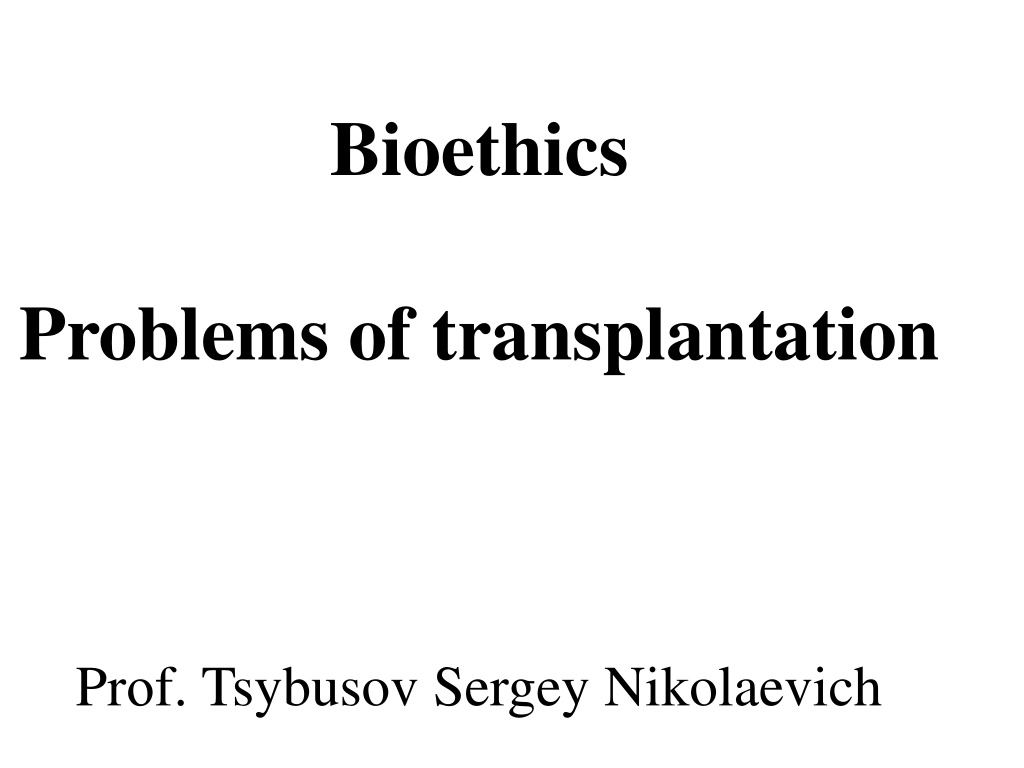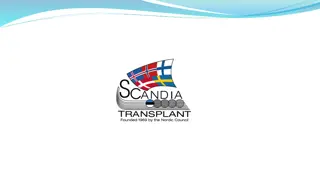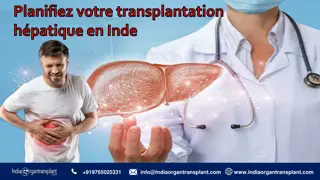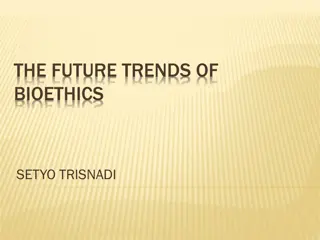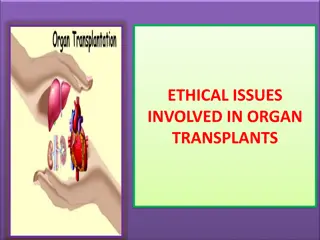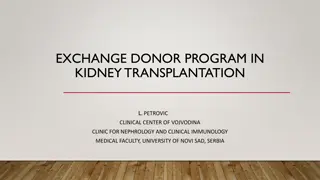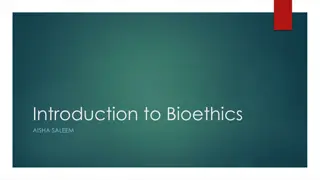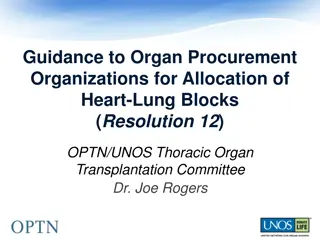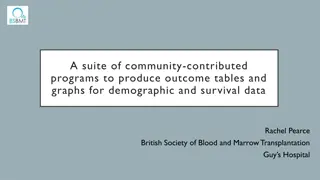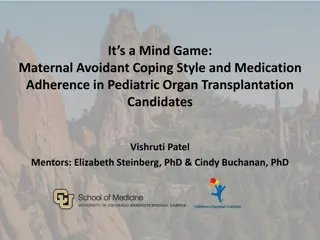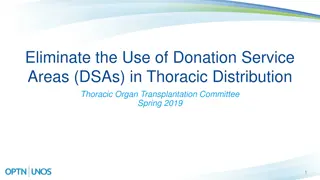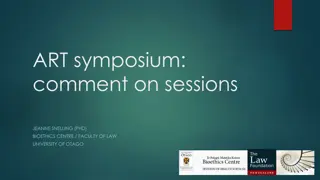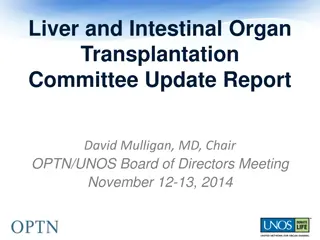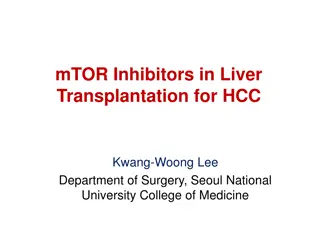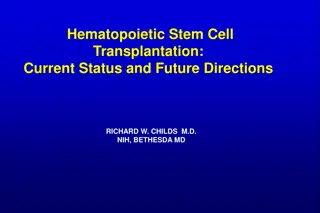Bioethics and Organ Transplantation
Bioethics delves into the complex field of organ transplantation, exploring the ethical considerations and scientific advancements surrounding autotransplantation, allo-or homo-transplantation, and xenotransplantation. Discover the history and innovations in this vital medical procedure, from legendary tales depicted in art to the pioneering surgeries conducted by Vladimir Petrovich Demikhov and Dr. Christiaan Bernard.
Download Presentation

Please find below an Image/Link to download the presentation.
The content on the website is provided AS IS for your information and personal use only. It may not be sold, licensed, or shared on other websites without obtaining consent from the author.If you encounter any issues during the download, it is possible that the publisher has removed the file from their server.
You are allowed to download the files provided on this website for personal or commercial use, subject to the condition that they are used lawfully. All files are the property of their respective owners.
The content on the website is provided AS IS for your information and personal use only. It may not be sold, licensed, or shared on other websites without obtaining consent from the author.
E N D
Presentation Transcript
Bioethics Problems of transplantation Pr f. Tsybusov Sergey Nikolaevich
TRANSPLANTATION (from Latin transplantare replant , replace ) is the process of replacing damaged or lost organs by transplanting the same organs taken from healthy organisms of the same species.
There are 3 types of transplantation: Autotransplantation transplantation in one organism Allo-or Homo- transplantation - transplantation in one species Xenotransplantation transplantation from one species to another
All transplantation operations are divided into: Transplantation of complexes(transplantation of a heart, kidney, liver, pancreas, heart-lung complex) and Transplantation of tissues and cell cultures (transplantation of bone marrow, cell cultures of pancreas, endocrine glands etc.) Sources of organ and tissue transplants: Cadaveric donation -75-90% Living donors Artificial organs and tissues Animal organs (xenotpansplants) organs or organ
In Italy in the Museum of St. Mark (frescoes of the 15thcentury) Saints Cosmas and Damian (3rd centuryAD) transplant the black leg of the Ethiopian onto the deacon Justinian.
Legendary transplantation Saints Cosmas and Damian, supported by angels,transplant the black leg of the Ethiopian into a white body.16th century painting.
Vladimir PetrovichDemikhov (1916-1998) In 1946 he conducted world s first heart transplantation into the chest of a dog. In 1954 he transplanted a head of a dog on to another larger dog
In 1967, the world's first successful human- to- human heart transplant was performed.
It was carried out by a pupil of V. Demikhov South African doctor Dr. Christiaan (Chris) Bernard.
The first successful heart transplant in Russia was performed by V.I. Shumakin in 1986.
Ethical concerns in transplantation 1. Commercial relations in transplantation 2. Brain-based determination of death (determination of death by criteria for brain death) 3.Explantation (removal) of organs and (or) tissues from a corpse or living donor 4.Fair distribution of available donor organs or recipient tissues
The danger of commercializing donation Trade in organs and tissues should be prohibited by law. Monetary exploitation of both patients who need donor material and donors who donate their organs for money inadmissible.
World Medical Association, Declaration on Human Organ Transplantation (1987). Purchase and sale of human organs for transplantation is condemned.
Law of the Russian Federation On the transplantation of organs and(or) human tissues (1992) Aban on purchase and sale of organs for transplantation was introduced.
REASONS FOR THE COMMERCIALIZATION OF ORGANAND TISSUE TRANSPLANTATION Shortage (deficit) of organs for transplantation, forcing patients to look for unusual sources of donor organs Impoverishment of a population, capable of pushing people to seek income even by selling their own organs Crisis in budget financing and inadequate financing through compulsory health insurance encourages medical institutions to commercializing their activities significant part of the fight for survival by
FACTS Every 18 minutes a new name was added to the waiting list for transplantation in 1998, every 16 minutes in 1999, every 14 minutes in 2001 and every 10 minutes in 2005. The speed of adding names to the waiting list has long exceeded the speed of exit from this list. More than 120 thousand people are currently awaiting the donor organ.
PROBLEM For the sake of saving one person, is a doctor entitled to harm the health and wellbeing of another person?
Potential donor's right to altruism and self-sacrifice Art. 13 of the RF Law On the transplantation Aliving donor may have a paired organ, part of an organ or tissue removed for transplantation, the absence of which does not entail an irreversible health problems the donor has no right to sacrifice his own life by giving an unpaired vital organ.
REMOVAL OF ORGANS AND TISSUES FROM A LIVING DONOR Art.11 of the RF Law On the transplantation is allowed under the following conditions: If the donor has given free, informed and specific consent to it in written form. If the donor beforehand has been given appropriate information as to the purpose and nature of the removal as well as on its consequences and risks. If the donor has undergone a comprehensive medical examination and has the opinion of a Council of medical specialists on the possibility of removing his organs or tissues for transplantation
PROBLEM For the sake of saving one person, is a doctor entitled to remove organs and tissues from a recently died person?
DEFINITIONS OF BRAIN DEATH Death of the entire brain, including the brainstem with irreversible cessation of independent breathing and absence of all brainstem reflexes. Death of the brain stem (however, signs of brain vitality, in particular electrical activity, may persist). Death of the parts of the brain responsible for consciousness, thinking, preservation as a person unconsciousness, i.e. for a man
DIAGNOSIS OF BRAIN DEATH Art.66 of the Federal Law of the Russian Federation No 323-FZ of 21.11.2011 "On the fundamentals of health protection of citizens in the Russian Federation The diagnosis of brain death is established by a consultation of doctors in the medical organization in which the patient is located.The consultation of doctors should include an anesthetist-resuscitator and a neurologist with at least three years of experience in the intensive care and resuscitation department.
Principle of organizational and financial independence of medical teams There should be three medical teams, each of which functions. The first states "brain death", the second carries out organ harvesting and the third - a team of transplantologists - performs organ transplantation. performs certain
Ethical and legal regulation of postmortem explantationof human organs and/or tissues The main source of organs and/or tissues for transplantation is cadaveric donation. There are several types of legal regulation of recovery of all transplantable cadaveric organs. There are three main models of recovery of all transplantable cadaveric organs: routine recovery of all transplantable cadaveric organs, the principle of presumption of consent presumption of disagreement and the principle of
Routine recovery The basis is the established practice according to which the authorities may, at their discretion, dispose of the body of a deceased person. In particular, they give health services the authority to perform an autopsy, to remove organs for scientific and other manipulations, and to use physiological fluids and tissues of a corpse for a wide variety of purposes. The human body in this case is considered as state property, which physicians can use in the public interest.
MECHANISM OF PRESUMPTION OF CONSENT(OR PRESUMED CONSENT) This principle differs from routine recovery in that although a special permission for posthumous organ donation is not requested, consent for it is presumed, i.e. refusal from such manipulation has not been registered. The current law on transplantation offers every adult while he or she is alive and his or her family after his or her death the opportunity to refusefrom organ and/or tissue donation.
PRESUMPTION OF CONSENT(presumed consent, objection model) Consent is presumed because people do not express their disagreement explicitly throughout life +The positive thing is that this principle source of a large number of organs and transplantation. - The negative thing is that the principle of presumption of consent forces the doctor to commit, in fact, action, because the action with a person or his/her property without his/her qualified in ethics as violence. provides a tissues for a violent consent is
PRESUMPTION OF DISAGREEMENT The presumption of disagreement suggests that the person does not agree in advance that his/her organs will be transplanted into another person. Organs can be removed from the body of a deceased person for transplantation when an individual or his/her family after specifically expresses desire to donate his/her organs. he/she dies
PRESUMPTION OF CONSENT AND DISAGREEMENT The presumption of consent is valid in Russia, Austria, Belgium, Spain, the Czech Republic, Hungary, etc. The presumption of disagreement is enshrined in the laws of the United States (partially), Canada, Portugal, the Netherlands and is actually valid in Poland. Germany, France,
. Yeah.., my dear, you are about to have a difficult social adaptation
FACTS Every 18 minutes a new name was added to the waiting listfor transplantation in 1998, every 16 minutes in 1999, every 14 minutes in 2001 and every 10 minutes in 2005. The speed of adding names to the waiting list for transplantation has long exceeded the speed of exit from this list. More than 120 thousand currently awaiting the donor organ. people are
CRITERIA OF THE "QUEUE" FOR ORGAN AND TISSUE TRANSPLANTATION - Degree of immunological compatibility in the donor-recipient pair" - Recipient severity criterion - Refusal to transplant donor organs into a patient suffering from diseases accompanied by damage to the peripheral vascular system, because of the potential risk for failure in organ transplantation.
BASIC ETHIC PRINCIPLES REGULATING THE HUMAN ORGAN AND TISSUE TRANSPLANTATION 1. Human organs cannot be considered as objects of purchase and sale. 2.Organ transplantation from a living donor can only be based on voluntary self-sacrifice to save the life of another person. In this case, consent to the removal of organs becomes a manifestation of love and compassion. 3.The potential donor should be fully informed about the possible health consequences of organ explantation. 4. From a moral point of view, explantation that directly threatens the life of a donor is unacceptable.According to Russian law, organ removal from a living donor is allowed only in case of donor- recipient genetic relationship, with the exception of cases of bone marrow transplantation. 5. It is unacceptable to reduce the life of one person, including through the rejection of life-supporting procedures, in order to prolong the life of another.
6.The most common practice is to remove an organ from people who have just deceased. Here it is necessary to eliminate ambiguity in determining the moment of death. 7. There are three principles for the ethically and correct diagnosis of brain death :the principle of a unified approach, the principle of collegiality and the principle of financial and organizational independence of medical teams. 8. Priority allocation of donor organs should not be determined by the identification of the benefits of individual groups and special funding. 9. When distributing donor organs, three criteria are taken into account: immunological donor-recipientcompatibility, severity of recipient status, and priority. 10. It is morally unacceptable to use the most unprotected and being in extreme situations contingents of people: homeless people, psychiatric patients, children, residents of economically backward countries. degree of
